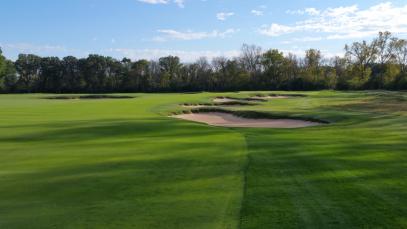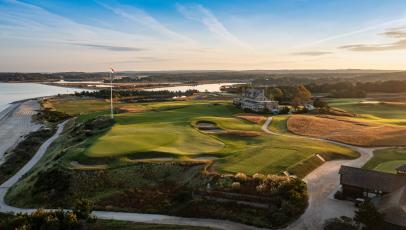Courses
A closer look at the 15 newcomers on our latest course rankings
One of the joys of compiling and publishing the Golf Digest America’s 100 Greatest and Second 100 Greatest Courses is seeing the debut of previously unranked courses. Sometimes they’re the hot new thing freshly bursting onto the scene, dazzling with irresistible charisma. This occurred with regularity during the golf boom of the 1990s and early 2000s. Other times—and perhaps more satisfyingly—they’re older courses that have been polished through renovation, or whose charms are just now being fully appreciated.
What causes some degree of sadness is knowing that as new courses come into the rankings, others fall off. Some of those departed courses might be shooting stars that flash quickly and then disappear, but more are like old friends we’ve known for years, if not decades, yet we must bid them farewell.
It's part of the life cycle of any course ranking endeavor: courses appear, slide up and down, and in all but a few cases, fade away. Just 16 courses in the U.S. have appeared in every iteration of Golf Digest’s rankings since 1966. Call these our “First Growths,” a term that originated in Bordeaux, France, to designate a 19th century assessment of the region’s top wine growing estates. Golf Digest’s First Growths are Augusta National, Baltusrol’s Lower Course, Congressional’s Blue Course, Cypress Point, Inverness, Los Angeles Country Club’s North Course, Medinah’s No. 3 Course, Merion, Peachtree, Pine Valley, Pinehurst No. 2, Riviera, Scioto, Seminole, Southern Hills and Winged Foot West.
For every other course in the land there are debuts and, later, in one form or another, exits.

Jeffrey Bertch
Here are the newcomers to America’s 100 Greatest and Second 100 Greatest Course, as well as the, for now, dearly departed.
34. OHOOPEE MATCH CLUB

From Golf Digest Architecture Editor emeritus Ron Whitten:
I’ve been told Gil Hanse had first examined the site of Ohoopee Match Club as far back as 2006 considered it ideal for golf: gently rolling terrain with no severe elevation changes, and beautiful sandy soil deposited by the nearby Ohoopee River, perfect for drainage and firm, fast conditions.
The ground around tiny Cobbtown, Ga., is also perfect for growing onions—it’s just northeast of Vidalia, world-famous for the Vidalia onion. Indeed, Ohoopee’s logo is a freshly picked onion, although if you look closely, its roots are three writhing snakes.
Any symbolism pertaining to match play is uncertain; perhaps it simply suggests the sort of putts one will face. What’s the composition of a course meant for match play? One might think it would contain lots of penal hazards, because a triple bogey on any particular hole would not be fatal in match play.
Perhaps the targets would be smaller than normal, to level the playing field between big hitters and short-but-accurate golfers. That’s not the composition of the 7,325-yard championship course at Ohoopee. Hanse did produce dramatic visuals in this sandy locale that hark back to portions of Pinehurst and Pine Valley, from long expanses of sandy rough dotted with native plants to deep, foreboding pits of sand, but they’re mostly on the far perimeter of holes.
Explore our complete review here—including bonus photography and ratings from our expert panelists.
49. NANEA

115. SHEEP RANCH

131. CLEAR CREEK TAHOE

140. MANELE

142. THE DYE COURSE AT WHITE OAK

The Dye Course at White Oak, our 2022 Best New Private Course winner, is one of the most exclusive golf courses to be built in recent memory. It’s located on the border of Florida and Georgia outside Jacksonville, in almost complete natural isolation. It has no members, no on-site clubhouse (or any other structures on or near the course), and hardly anyone has played it except for personal invitees of owner Mark Walter and several dozen Golf Digest panelists, who visited between October 2021 and September 2022. Walter engaged the late Pete Dye to design the course in 2013, but by the time construction began in 2017, Dye’s health had deteriorated, and he was no longer able to be active in building it. The job of finishing White Oak fell to longtime confidant and veteran course builder Allan MacCurrach, who interpreted Dye’s wishes based on extensive discussions from previous years and his own wealth of experience working with Dye on over 20 projects. Intensely private and almost entirely off the radar until now, this exclusive video tour captured by photographer Brian Oar offers the first public looks at The Dye Course at White Oak.
144. BLESSINGS

153. SAGE VALLEY

164. OLD ELM

170. HOLLYWOOD

175. ATLANTIC

176. RESERVE AT MOONLIGHT BASIN

180. THE BEAR'S CLUB

From Golf Digest Architecture Editor emeritus Ron Whitten:
The Bear’s Club marked a transition point in Jack Nicklaus’ design outlook when it opened in 1999. His architecture had typically been analytical and, while still lovely, oriented toward factoring how players might break down the features tactically. That strategic backbone is present in The Bear’s Club, but the team approached the design more holistically than they had previously, factoring in aesthetics to an unprecedented degree. Instead of building holes on a golf site, Jack and his associates created a golf environment, expanding and enhancing a dune ridge running through the low pine and palmetto scrub and anchoring large, sensuous bunkers into the native vegetation.
The course is part of an upscale residential development near the Intracoastal Waterway, but it blends so well you wouldn’t know it. The change in perspective that Nicklaus Design developed at The Bear’s Club pushed the firm toward similar successes in the 2000s like Sebonack (with Tom Doak), The Concession and Mayacama.
181. MEDALIST

186. KARSTEN CREEK

196. SANKATY HEAD

197. THE HARVESTER CLUB

• • •
Explore Golf Digest's recently relaunched Places to Play community, where you can add star ratings and reviews for all the courses you play. We've collected tens of thousands of reviews from our course-ranking panelists to deliver a premium experience, which includes experts' opinions, bonus course photography and videos, plus much more. Check it out here!




